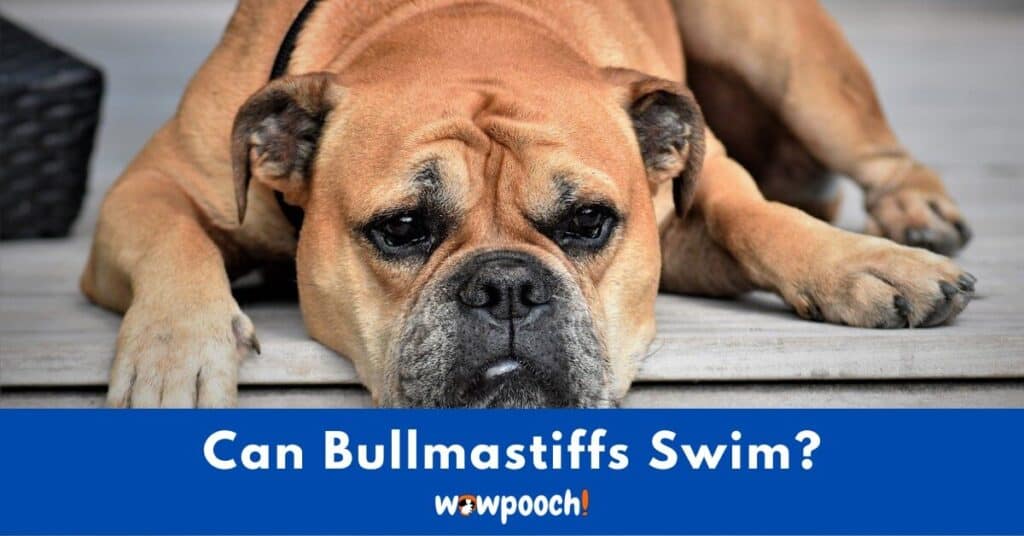You’ve come to the right place if you’ve ever wondered whether your Bullmastiff can swim or not. This isn’t the first time you’ve felt that way. Among dog-related communities, this is one of the most asked questions of veterinarians.
So, Can Bullmastiffs Swim? Not all dogs can swim, and not all dogs want to be in the water, which should come as no surprise. Your Bullmastiff, but, can learn to swim with proper practice.
I’ve figured out the possible answers for Bullmastiffs. For more detail, keep reading. I’ve also added a few more points. These resources will help you figure out what’s off with your Bullmastiff.

Are Bullmastiffs Good Swimmer?
Bullmastiffs are not offered, awesome swimmers. Since their immense body size and form have a minor effect on their swimming ability. But, do not worry. With enough persistent preparation, your Bullmastiff puppy will be able to swim well. Trained Bullmastiffs can swim much like other dog breeds.
Thus, the webbed feet of Bullmastiffs make a significant contribution to this. They paddle and move across the water using their webbed feet. Those webbed feet work on paddles. Even so, bear in mind that many Bullmastiffs seem to be unable to swim that well.
Occasionally, many of them have been involved in water-related incidents. So, you must be careful about your pooch’s safety.
Do Bullmastiffs Like To Swim?
During the summer, you may see pups are swimming at beaches and neighborhood pools. Indeed, your Bullmastiff pup also takes pleasure in swimming almost as much as you do.
Swimming is an excellent way for your pet to stay cool on hot days, get some exercise, and have some fun at the same time. The majority of Bullmastiff pups enjoy swimming for several excellent reasons.
The first reason is that their bodies are designed to swim. And the second reason is that dogs are exposed to water fun at a young age. These two factors combine to make swimming enjoyable for Bullmastiff puppies.
Related Reading: Do Dalmatians Like To Swim?
Do Bullmastiff Dogs Like Water?
Dogs, like humans, enjoy lakes, ponds, the sea, and hot tubs. And, particularly during the summer, water is a lot of fun and helps to cool your pup down. Additionally, swimming is an excellent form of exercise for your four-legged companion. It strengthens his heart and lungs by stimulating all his muscles.
How Long Can Your Bullmastiff Swim In The Water?
This is more a matter of aesthetics for your Bullmastiff pet. You will observe several dogs that can swim 100 feet without tiring. It is more dependent on the environment in which your puppy is familiar. If they are not used to working long hours on land, they would most likely behave similarly in water.
Yet, your Bullmastiff should be able to swim for at least 30 minutes, since this is the industry norm. In general, a well-maintained swimming pool is safe for dogs to swim in.

5 Cool Facts: Why Your Bullmastiff May Love To Swim?
Swimming is a passion shared by dogs of all ages. Additionally, your Bullmastiff puppy enjoys swimming too.
#1 Does Your Bullmastiff Love To Get Buoyant For A While?
Your pet enjoys the motion associated with submerging in water. Water’s buoyancy mitigates gravity’s influence, allowing the body to balance in the water. Swimming is an excellent workout for your furry friend. Because it reduces tension on the joints, bones, and muscles.
Your Mastiff pup can travel more in water. It enables them to engage in weightless activities that they cannot do on the ground.
#2 Is Your Bullmastiff Doing This From Her Positive Association?
Usually, people believe Terriers, Beagles, and Newfoundlands are natural water lovers. There are various dog breeds that have natural swimming ability.
The basis of a dog’s enthusiasm for water is coming from associating with the other dogs in the water. Just like children, your Mastiff pup needs to know he is safe in the water before they can enjoy the fun of swimming. Your pup must have the confidence to trust the order to learn to dive.
#3 Is Your Bullmastiff Doing Exercise?
Exercise is the clearest explanation of why Bullmastiff dogs enjoy swimming. If your puppy has learned to swim, they become naturals and adapt. This low-impact exercise is beneficial to your pup’s health.
Water-resistance stimulates muscles to work harder thus creating the sensation of being weightless. It’s the ideal exercise for your canine to get a decent workout. Your pet would fall asleep like a log after a successful swim session.

#4 Is Your Bullmastiff Reducing Mental Stimulation?
Bullmastiff dogs are prone to boredom, as any doggy owner will testify. Swimming is not only a source of physical stimulation for your doggy but also beneficial for his mental health. While swimming, a dog’s posture changes from a trot to a paddle. All you begin your first swimming lesson by mastering the ‘doggy paddle’.
Does doggy swimming seem to be very normal to you? Trust me, there is a greater emphasis on their body movement than many know. Their brains are assessing the action and surroundings as they swim. Many dogs increase their concentration and desire this way. This keeps him involved in this enjoyable task.
#5 Is Your Bullmastiff Doing Fun?
Bullmastiff puppies enjoy swimming like children in a pool. It’s difficult to pull them out. One minute swimming equals four minutes of land exercise. It’s difficult to beat the sensation of being weightless while the body is working out.
Swimming relieves discomfort, joint pain, asthma, and mobility problems for them. Your pet enjoys pleasant swimming in a clean, supervised environment.
Related Reading: Why Does Your Border Collie Love To Swim?
Things To Consider Before Your Bullmastiff Swim in The Water
If you’re considering taking your pup swimming, you might want to reconsider. Although you may believe your pet is a natural in the water. The reality is that swimming is not enjoyable or even pleasant for a large percentage of dogs.
Don’t Leave Your Bullmastiff Unsupervised
Your Mastiff puppy should never be left unsupervised while swimming. Particularly in bodies of water with tides, such as rivers and oceans.
Dogs are unable to catch an object efficiently with a single paw and must rely on their paws or mouths to hang on. There is a greater risk that they would be unable to pull themselves to safety to avoid a current.
If you are uncertain of your pup’s capabilities, you should hold him on a solid, well-made long line of 20 to 30 feet. So you can pull him in if necessary.
Additionally, keep in mind that certain currents are stronger than those visible on the surface. Especially in larger waterways and oceans.
Don’t Go With Your Bullmastiff For Swimming in Unfamiliar Waters
Unknown waters imply the presence of unknown threats, some of which may be fatal. For example, snakes are a serious risk on riverbanks. Certain snakes like to hide in small holes in the ground or under rocks. So use extreme caution when allowing your pet to explore areas where they can startle a snake.
Apart from animals, keep an eye out for sharp rocks or shells (which can cut your pet’s feet) and varying water depths. If you are unsure of the depth of the pool, check it out before allowing your puppy to enter.
Another overlooked hazard is blue-green algae. It can cause serious stomach pain as well as irritation of the eyes, ears, throat, and skin. Since many dogs swallow some water while swimming, the blue-green alga is a problem. This is particularly true during the warmer months. In that time algae bloom as the water temperature increases.
Don’t Let Your Bullmastiff Get Too Tired
A significant danger for your pup is when he becomes exhausted far out from shore in a waterway. And he is unable to return. Bullmastiff dogs who like swimming get very excited at the thought of swimming. They can bite off more than their physical strength allows.
The safest course of action is to never leave your Mastiff canine alone in the water. Including a lake, where he might sink or jump in and become trapped and unable to escape.
In lakes, the very first thing you can teach your pet is the location of the exits. So that he is capable of exiting on his own without help.
Gradually increase your pet’s endurance in the water. Determine the exact time it takes for your puppy to exhibit. These are the most basic signs of exhaustion. Additionally, a waterway with a current can exhaust your puppy faster than swimming in a pool.
Don’t Ignore Cold Weather
A general rule is – you should never expose your pet to temperatures that they’re uncomfortable with. Bear in mind that your puppy cannot communicate whether he is hot or cold, so you must rely on their signals. If the water is too cold for you, it will be too cold for them as well.
Coldwater exposes your pet to hypothermia, a condition. In which their body temperature falls below the usual range of 100 to 102.5 degrees Fahrenheit. When hypothermia sets in, blood flow is accelerated from the skin’s surface. It extremities to vital organs such as the heart, lungs, and brain.
Your dog’s muscles need enough blood flow to work hard while they swim. And colder water may prevent the delivery of oxygen. The muscles of your canine become fatigued, and the chance of drowning increases.
Related Reading: Can Cane Corso Dogs Swim?
Things To Do After Your Bullmastiff Finishes Her Swim
- Does your Bullmastiff jump in and out of the pool at random times a day? Spray his coat with cool water after each swim or at the end of each day.
- Rinse for an extended period of time to drop all chlorine and other pool chemicals.
- If necessary, towel-dry or blow-dry your pup’s hair.
- If your Bullmastiff pet’s coat is medium or long, follow the rinse with another coat. Spray conditioner and a comb-through. Get all the way down to the skin, and mats will conceal themselves, becoming tighter as they dry.
- Comb out all tangles. Bathe him with a gentle moisturizing shampoo. Use a conditioner that will remove chlorine residue. Replenish a dry coat with moisture.
- Consider using a gentle anti-itch shampoo, such as oatmeal or aloe. It helps soothe sore skin while also dislodging any residual seashore debris.
- Give your pup a thorough shampoo and conditioning with gentle moisturizing products about once a week.
Are Bullmastiffs Scared Of Swimming?
The primary reason Bullmastiff dogs and related breeds seem unable to swim is due to their Brachycephaly. Due to their short snouts, they must elevate their faces to keep them out of the water.
As a result, tilted-up dogs have a harder time keeping afloat. Yet, they are not afraid of water. They, like other dog breeds, enjoy swimming with proper preparation and assurance.
What Will Be Bullmastiff Puppies’ Swimming Lesson?
While teaching your Bullmastiff puppy to swim, it’s important to avoid negative experiences. Find out that the water is not too cold, and never throw or force your dog into it. Rather than that, entice him in with a water toy or treat. Many dogs would gladly enter as long as they could feel the bottom.
How to Train Your Bullmastiff Puppy To Swim Well?
- Begin slowly. You should let your Mastiff pup take his time.
- If your Mastiff pup’s breathing becomes effortful or his back begins to sink in the water, it’s time to exit and relax.
- Have a great time teaching your pup to swim. You should ensure that your canine is having a good time in the pool.
- There are some other enjoyable things you can do with your canine companion to spice up your swimming session. So that, your Bulldog does not get bored.
Bullmastiff’s Behavior & Health Related Questions:
Are Bullmastiffs Friendly?
With family members, Bullmastiffs are gentle and affectionate. Their usually quiet, easygoing attitudes make them ideal for families with well-behaved children. These dogs are suspicious of strangers. Despite his familial devotion, the Bullmastiff is no coward.
Do Bullmastiffs Like To Cuddle?
Bullmastiffs are affectionate and enjoy bonding with their owners or friends. With daily exercise, they love snuggling up after a hard day of work or play.
This Mastiff breed enjoys cuddling. They cuddle to unwind, bond, and stimulate the release of feel-good hormones. Cuddling goes all the way back to when dogs were reliant on their bodies to stay warm.
They stayed warm by interacting with one another and with other humans. This demonstrates that Bullmastiff puppy cuddling benefits both the dog and the owner.
Why Do Bullmastiffs Lean On You?
Bullmastiff puppies lean on you to stay close to you. Small dogs can be picked up and cuddled. Larger dogs will do anything to get near, including leaning heavily on you. Leaning is an entirely harmless trait in dogs. It is typically associated with warmth and affection.
Why Do Bullmastiffs Howl?
Bullmastiffs howl to communicate with other dogs, in response to sounds, and when separated from their owners. If your furry friend howls in response to loud noise, such as an alarm or siren, he or she might be overstimulated. They howl to draw attention, interact with other dogs, and alert others to their presence.
Certain breeds of puppies howl in response to loud sounds, such as warning sirens or musical instruments. Howling incessantly can mean that your pup is in distress.
Why Does Your Bullmastiff Stink?
How often do you bathe your Bullmastiff? Irregular washing often causes undesirable odors. The same happens if you do not brush your doggy daily.
The anal glands are near the anus and must be expressed on a daily basis. To avoid bacteria accumulation and the occasional infection that causes odor.
Are Bullmastiffs Hard To Train?
Bullmastiffs are strong and stubborn. They can put your family members to the test. However, your pup may respond to early obedience training. That incorporates cheerful praise and food rewards. You need to be patient with your Mastiff friend in this case.

Over To You
It can be very calming to watch your Bullmastiff puppy swim. You should, yet, be mindful of extra dangers that could affect your Mastiff friend.
I’ve attempted to provide something helpful in this situation. Tell me which fact was most beneficial to you, which you already knew and which you didn’t.
Kindly notify me if you wish to try any of the tricks or if you have already tried any of the techniques.
Also, please notify me if I’ve missed anything. Please provide your constructive feedback on this post. If you enjoyed this read, please share it with others. Kindly leave some comments in the section below.
We appreciate your time in reading this.
Further Readings:
